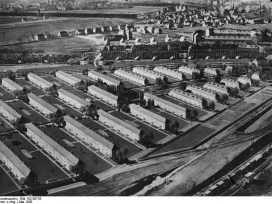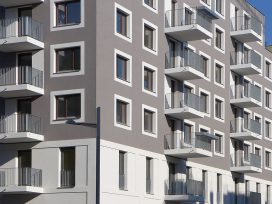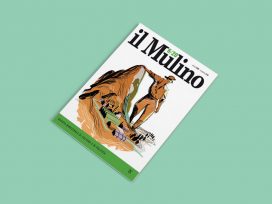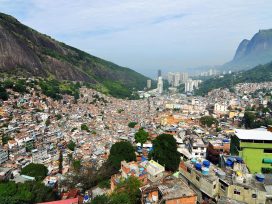“The future of warfare lies in the streets, sewers, high-rise buildings, industrial parks, and the sprawl of houses, shacks, and shelters that form the broken cities of our world. We will fight elsewhere, but not so often, rarely as reluctantly, and never so brutally. Our recent military history is punctuated with city names – Tuzla, Mogadishu, Los Angeles, Beirut, Panama City, Hue, Saigon, Santo Domingo – but these encounters have been but a prologue, with the real drama still to come.”
Major Ralph Peters, US Army
The camera is shaking. The focus is poorly adjusted. Some seconds pass before you can tell what the film depicts.
Then the focus is sharpened. At once, the scenario becomes uncomfortably clear: the man half-lying on the ground; the group of policemen surrounding him with truncheons in their hands. Then the beating begins. The kicks. The assault goes on for a minute and a half.
It is three minutes past midnight on the 3 March 1991. When the film stops, Rodney King is lying motionless on the ground.
Slightly more than a year later, on 29 April 1992, the four policemen who assaulted King are cleared of all charges by a unanimous jury. That same day, Los Angeles erupts in violent riots, the most brutal in US history. Riots lasting six days. Entire blocks are burned down, more than 50 people are killed and thousands are injured. Not until the National Guard seizes the streets of Los Angeles does the violence come to an end.
Two years earlier, in 1990, the then fairly unknown historian and urban theorist Mike Davis published his analysis of the history and future of Los Angeles, City of Quartz. His excavation of social and ethnic tensions in Los Angeles suddenly seemed prophetic. In a stroke, Davis was transformed into an internationally established and esteemed social critic, his books and articles gaining readers far beyond the academic world.
Now, I am sitting in his kitchen in a small villa in central San Diego. Scratching away on his grey beard, he takes some vigorous sips of coffee and points out that the riots are still an open wound in the history of Los Angeles. Instead of trying to find explanations, most people in power have tried to forget.
“All we got was a story of police brutality which triggered the black community in Los Angeles to violence. But that is just a small part of the truth. It wasn’t primarily African Americans who were looting stores and starting fires around the city. If you look at the arrests made by the police it appears that principally Latin Americans were responsible for the riots. And a closer look at the causes shows a web of explanations where police brutality is only one background among others.”
Mike Davis emphasises the poverty that affected great parts of the population of Southern California when the economy entered a deep crisis at the beginning of the 1990s. Particularly hit were Latin American immigrants, people who during the 1980s had already experienced sinking wages and more limited options in life.
“The upheaval should really be described as a postmodern bread riot. Clear warning signals were apparent the months preceding. There is a photo which more than anything describes what was about to happen. Three days prior to Christmas eve, the Los Angeles Times published a picture showing thousands of Latin American families lining up outside a soup kitchen Downtown.”
Los Angeles is a patchwork of different worlds. This is not a melting pot – rather a map of the global power order, divided up according to the same ethnic divisions. On the way from my hotel in Santa Monica to meet Davis, I exit the highway and drive through the Watts district. The poverty is so palpable that I am taken by surprise. This black part of town appears to be entirely disconnected from the rest of the world. Hardly any shops at all. No restaurants. Just old houses in various stages of ruin. This is the third world immersed in the first, a sprawl with thousands of inhabitants plagued by unemployment, gang crime and a shortage of public resources. There are only two options for this district of Los Angeles, I think: implosion or explosion, ruin or revolt.
If one reads the statistics, the road to ruin seems already determined. In districts such as Watts, a veritable civil war has been going on since the 1980s. The youth are killing each other to such an extent that war is the only applicable word.
Some hours later, I ask Davis precisely this: implosion or explosion? His answer is clear: both.
“Los Angeles will in all likelihood experience new disruptions. If the economy keeps falling at the current rate, it is just a matter of time before the city explodes in new riots. At the same time, it is obvious that districts such as Watts and Compton are in the process of destroying themselves. Even if gang violence has decreased somewhat over the past couple of years, it is still at a level as to be compared to war.”
But, he concedes, it is important to broaden one’s scope and place the development of these districts in a much larger perspective. From a pile of books, he pulls out one of his latest – Planet of Slums – and says that today one can identify four tendencies in the evolution of cities.
First, we have an urban growth that is detached from economic growth. Cities, above all in the South, tend to grow rapidly despite, in many cases, a receding economy. This growth is primarily powered by poor people from rural areas, who are drawn into the cities and their slums. Second, prevalent definitions of what a city is are beginning to lose their descriptive value. Nowadays, urban growth occurs mostly in the city peripheries, both economically and in terms of population.
“We are getting an entirely new urban landscape, a landscape which is neither city nor countryside. The rapid growth of slums outside the cities in the third world is one example. The immense areas of villa suburbs, shopping malls and workplaces here in Los Angeles, as well as other parts of the western world, is another.”
Third, we now have great city areas that are entirely disconnected from the global economy; in the third world it is the slums, in the US it is areas like Watts and Compton; in Europe it is suburbs like Clichy-sous-Bois outside Paris. This development in turn forces people to make their living in informal ways, opening doors to criminality, extremism and fundamentalism, Davis suggests.
“This is a development no one has foreseen. No one saw some decades ago that such a large portion of the world’s population would live in big city areas entirely without connection to the world economy. The people of the slums are furthermore of a social class that does not fit into our prevalent description of social stratification. They lack, for instance, the social power that the working class possessed at the beginning of the twentieth century.”
“The labour movement had strength since it could halt production; industrialisation had a tendency to unite people. Yet the logic of informal economy appears to be the opposite. The informal economy drives people to exploit each other, in the worst case yielding to nihilistic violence, like the street gangs in Los Angeles.”
It’s easy for people in power to turn their back on people living in the slums, Davis asserts. From a neoliberal perspective, they are superfluous. At the same time, he points out, it is dangerous to ignore the problems created by the global economy. In his two books, The monster at Our Door. The Global Threat of Avian Flu and Buda’s Wagon. A Brief History of the Car Bomb, which both came about during work on Planet of Slums, Davis describes two examples of why it is entirely faulty to pretend that the problems of the slums only concern the slums.
“Global epidemics and global terrorism are two problems that principally emanated from the slums. When one talks about ‘failed states’ one often means ‘failed cities’, such as Gaza, Sadr City or the slums of Port-au-Prince.”
What is truly interesting and horrifying is that the American military recognised this condition early on, much earlier than any one else. And it recognised this development from a very practical perspective, not a theoretical one. According to the military, these slum areas are the battlefields of the future. That is where the battle will be fought.
“Two events in American twentieth-century military history determined this direction more than anything. First, the blowing up of the American embassy in Beirut at the beginning of the 1980s; second, the retreat from Mogadishu at the beginning of the 1990s. Both events have been of greater importance to contemporary tactics and strategy development than the war in Vietnam.”
In reality, Davis states, the opponents in this war are militarily weak. They are narcotics syndicates, street gangs and terrorists. The problem is the terrain. For this reason, the American military has been working hard for a number of years on developing new tactics to take on the urban slums.
“The most interesting thing happening right now is the joint efforts of the US and Brazil in Port-au-Prince, Haiti. I would argue that the US sees that effort as a possibility to test and develop strategies to stabilise cities by means of security measures, city planning and social efforts. A sort of modern equivalent of Haussmann’s mop-up operation of Paris in the nineteenth century.”
Against this explosive world of poverty there are isolated islands for the global elite, what Davis terms the “paradise of evil”. In the anthology Evil Paradises. Dreamworld of Neoliberalism, he and a number of other writers and academics describe a world in denial. In gated communities across the globe, elites shield themselves from the brutal reality of the neoliberal economy.
“If Southern California has any significance to the development of the world’s cities, it is as model for life in the protected enclaves.”
Or, as he writes in the introduction to Evil Paradises:
Many of the “dreamlands” described in the pages that follow are, in fact, iterations of Los Angeles, or at least “California lifestyle”, as a global phantasmagoric ideal, which the nouveaux riches pursue with the same desperate zeal in the desert of Iran and the hills of Kabul as they do in the gated suburbs of Cairo, Johannesburg, and Beijing. But, as in autochthonic Los Angeles, Hell and the Mall are never more than a freeway drive apart. Thus, the real housewives of Orange County, like their counterparts in Hong Kong’s tony-phony “Palm Springs” or Budapest’s neo-Hapsburg gated communities, exploit the same labour of maids who themselves live in slums or even chicken coops on the roofs of mansions. The Metropolis-like phantasmagoria of Dubai’s super-skyscrapers or the Olympic megastructures in Beijing arise from the toil of migrant workers whose own homes are fetid barracks and desolate encampments. In the larger perspective, the bright archipelagos of utopian luxury and “supreme lifestyle” are mere parasites on a planet of slums.
Los Angeles, November 2019. In the overpopulated and rundown city, Rick Deckard struggles to stay sane. He is a “blade runner”, a cop with a mission to kill genetically produced replicas whose only crime is that they want to be real people. Against a backdrop of ruin, criminality and uninhibited commercialism, Rick Deckard hunts around a dark Los Angeles. There is no room for humanity or intimacy here – just raw loneliness. And floating above all of this are giant advertisement shuttles that cry out their message: buy your freedom, leave the metropolis for a happy life in the extraterrestrial suburbs.
Davis often returns to Ridley Scott’s dark depiction of a future Los Angeles in the film Blade Runner (1982). Perhaps not so much because he finds it realistic, but because of his interest in the dystopian and apocalyptic. He states that he readily investigates the underside of things; that he prefers to emphasise the anomalous and negative. He himself describes it as a method; that by focusing on the negative, he sees new patterns and new connections.
While this method has proven to be successful, he has received a lot of criticism for his one-sided focus on all that is negative. Especially for the book Ecology of Fear. Los Angeles and the Imagination of Disaster (2000), which could near enough be described as a standalone sequel to City of Quartz, which was heavily criticised on precisely that point. Davis was accused for ignoring any information that contradicted his image of Los Angeles as a society on the verge economic and social breakdown. The same criticism has been directed to his description of slums in Planet of Slums.
“It is no secret that I am fascinated by the apocalyptic side of our society. At the same time, I think that the criticism is a bit misleading. I don’t singularly look at the dystopian”, he says and points out that one of his later books, Magical Urbanism. Latinos Reinvent the US City, has a decidedly positive tone.
“In it, I describe how Latin American immigration is beginning to revitalise our American big cities. By means of the Latin Americans, many dead and rundown districts in cities such as Los Angeles and New York are gaining new life. Furthermore, a much more urban life than the suburban life that has pervaded many American cities in the post war era.”
But though there are positive streaks throughout his many books and articles, it is nevertheless the dystopian that remains in the mind.
At the end of Ecology of Fear, Davis paints a picture of American big cities of the future. It is something like a modern version of the Chicago School’s famous division of Chicago into different zones. In Davis’ picture of big city development, fear is one of the strongest forces. Fear of criminality and drugs force the middle class and capital ever further towards what are now known as “edge cities”; meanwhile, the inner city is divided into different zones. Some are safe and under close surveillance, others are abandoned by authorities and surrendered to crime, abuse and the informal economy.
At the centre of Davis’s image there is a small core to which all the big city’s homeless are drawn. And way out in the periphery is the ring of prisons. That is what the ecology of fear looks like.
And it is propagated throughout the world.






